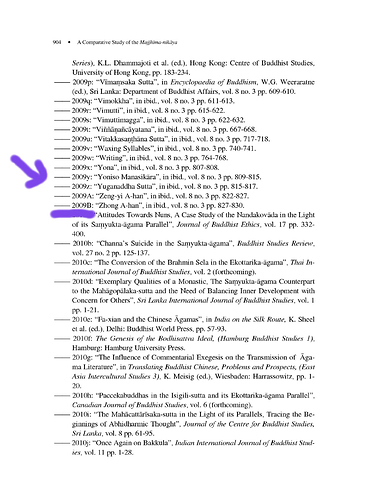As many of you know, Prof. Dr. Bhikkhu Anālayo is the most prolific scholar currently active in the field of early Buddhism. In 2019 alone he has published sixteen articles in academic journals (not counting other publications)—and the year hasn’t finished yet. As someone who’d like to delve deeper in his work this posed a problem for me: how to reference his work when making notes? The author-date system quickly gets overburdened; one would have to introduce Anālayo (2019a), Anālayo (2019b), etc.—potentially all the way up to Anālayo (2019p) and Anālayo (2019q). Or alternatively, one would have to use improvised abbreviations/links for the relevant articles.
As neither of these options particularly appealed to me, I decided to create my own reference system as an addition to the formal author-date system. I decided to share it here; perhaps it might be of use to others.
I have thought it prudent to the fourfold classification Anālayo used on his University of Hamburg (henceforth, UHH) homepage: (i) books, (ii) articles or chapters in books, (iii) articles in journals, and (iv) encyclopedia entries. I will use a distinct but similar reference system for each category.
I. Books
Below is the first book listed on Anālayo’s homepage (see link above):
- Bhikkhunī Ordination from Ancient India to Contemporary Sri Lanka, New Taipei City: Āgama Research Group, 2018.
I have abbreviated this book as [BHI18]. The first three letters refer to the first three alphabetically pertinent characters, “Bhi” in this case, converted into all-caps (characters with diacritics such as ī and ā are converted into their capital counterparts Ī and Ā). Though the notion of alphabetical pertinence is somewhat vague, this shouldn’t lead to major confusion; in practice only the articles “a”, “an” and “the” are ignored. The number indicates the final two digits of the year in which the book was published. As none of Anālayo’s research was published before the 21st century, this shouldn’t lead to confusion.
Some of his books have been translated, e.g. [SAT03], Satipaṭṭhāna, the Direct Path to Realization, has been partially translated into Sinhala in 2003 and fully into Italian in 2018. I propose to reference the Sinhala translation as [SAT03-si03] and the Italian translation as [SAT03-it18]. The “si” and “it” come from the two-letter ISO 639-1 abbreviations for modern languages also used on SuttaCentral; the number refers to the year in which the translation was published.
II. Articles or Chapters in Books
First item listed:
- “Achtsamkeit aus frühbuddhistischer Sicht” in Achtsamkeit, Ein buddhistisches Konzept erobert die Wissenschaft, mit einem Beitrag S. H. des Dalai Lama , M. Zimmerman et al. (ed.), Bern: Hans Huber Verlag, 2012, 277-290.
I have abbreviated this chapter as [ach12-de]. As before, the first three alphabetically pertinent characters “Ach” are displayed, this time in lowercase to distinguish them from the first category of books. The “-de” at the end indicates that the relevant chapter is in German. (A chapter translated into German in 2012 from an 2012 English original would be abbreviated as [ach12-de12]. Similarly, an 2022 English translation of the 2012 German chapter would be [ach12-de-en22].)
Below are some tricky cases and the abbreviations I’d use for them.
Forthcoming publications
- [com-forthcoming] “Comparing the Tibetan and Chinese Parallels to the Cūḷavedalla-sutta”, in Investigating Principles: International Aspects of Indian Cultures , L. Shravak and S. Roy (ed.), Mumbai: Somaiya Publications Pvt. Ltd. (forthcoming).
Publications with identical abbreviations
-
[und15a] “Understanding and Practicing the Ānāpānasati-sutta”, in Buddhist Foundations of Mindfulness , E. Shonin et al. (ed.), Cham: Springer, 2015, pp. 55–69.
-
[und15b] “Understanding and Practicing the Satipaṭṭhāna-sutta”, in Buddhist Foundations of Mindfulness , E. Shonin et al. (ed.), Cham: Springer, 2015, pp. 71–88.
Here I have borrowed the -a, -b, etc. notation also found in author-date, e.g. Anālayo (2015a) and Anālayo (2015b). The alphabetically first work is assigned -a, and so on.
III. Articles in Journals
First article:
- “Adding Historical Depth to Definitions of Mindfulness”, Current Opinion in Psychology,Special Issue on Mindfulness , 2019, 28: 11–14.
I have used the abbreviation [Addi19]. The first four letters of the article are picked (ignoring an initial “the”, “a”, or “an”). I have left them in their original case; e.g. [OnTi19] refers to
- “On Time”, Insight Journal , 2019, 45: 11–20.
Articles with multiple years
- [Disc14/15] Discourse Merger in the Ekottarika-āgama (2), The Parallels to the Kakacūpama-sutta and the Alagaddūpama-sutta" , Sri Lanka International Journal of Buddhist Studies ,2014/2015, vol. 12 pp. 63–90.
Articles without a year listed
- [Effe19] Effects of Mindfulness-Based Positive Behavior Support (MBPBS) Training Are Equally Beneficial for Mothers and Their Children With Autism Spectrum Disorder or With Intellectual Disabilities", (in collaboration with Nirbhay N. Singh, G.E. Lancioni, B.T. Karazsia, R.E. Myers, and Y.-S. Hwang), Frontiers in Psychology , 10.385: 1–13.
Though the year is missing from the citation, a quick search reveals that the article was published in 2019.
IV. Encyclopedia Entries
- “Āgama/Nikāya”, in BEB, 2015, vol. 1 pp. 50-59.
I settled on [āgama05], using the full first word of the entry in lower case (to prevent overlap with the other categories) together with the year.
Some (Potential) Drawbacks of This System
-
I’m heavily relying on the bibliography provided at Anālayo’s homepage, which may not exist anymore in the future. The good news is that this page has been backed up nine times in the Wayback Machine (and I just archived it for the tenth time). The UHH bibliography may not be complete, but any remaining publications may be referenced as above.
-
Some (future) publications might fall outside the four categories or might not be unambiguously classified into a single category.
-
There is still some ambiguity left, especially because of the -a, -b, etc. notation.
-
In any formal writing, the relevant citations should still be included, and the abbreviation system may need to be justified or explained.



